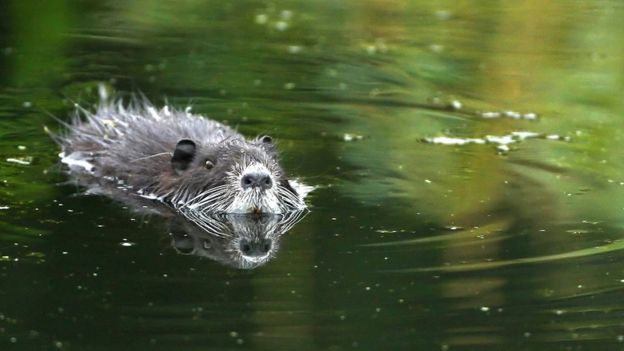We’re officially caught up with beaver news. For a month I have had a stack of articles waiting to tell you about because apparently August is the right time for good beaver news. Now it’s September and we’re moving into the days soon of BAD beaver news. Beavers in the fall are raising their dams and people are getting worried about flooding. Soon we’ll hear about the reasons folks in Wichita or Boise need to trap.
But there’s one last victory to celebrate. 
Funding for prospective students
Dam beavers: quantifying the impacts of nature’s water engineers on the fluvial geomorphology and flood regimes of streams and rivers, Geography – PhD (Funded)
The University of Exeter’s College of Life and Environmental Sciences, in partnership with the National Trust, is inviting applications for a fully-funded PhD studentship to commence in October 2020 or as soon as possible thereafter. For eligible students the studentship will cover UK/EU tuition fees plus an annual tax-free stipend of at least £15,285 for 4 years full-time, or pro rata for part-time study. The student would be based in Geography in the College of Life and Environmental Sciences at the Streatham Campus in Exeter.
The Eurasian Beaver (Castor Fiber) was hunted to extinction in Great Britain and near-extinction in Europe. Over recent decades, it has made a comeback, with numbers now nearing 1 million in mainland Europe and with a number of reintroductions and licensed trials established in GB to improve understanding of the role that this ecosystem engineer might play if more widespread. Since beavers were absent from GB, landscapes have been modified extensively in support of agricultural intensification, with an emphasis upon the drainage of the land to deliver enhanced production of food. Waterways are now straightened and deepened, fields under-drained and often bare of vegetation, to maximise drainage efficiency, but with detrimental impacts downstream. Thus, there are very few, if any ‘natural’ streams or rivers in GB, which means that research is required to understand what impact beavers might deliver, as they return into densely populated, intensively-farmed ecosystems. This PhD will deliver new understanding of the ways in which streams and channels will respond to beaver activity and will therefore provide fundamental science to guide both decision and policymakers and land managers as to how to respond.
How much do you want to be THIS PhD candidate? Hired to measure streams or walk around dams for 4 years as a fully funded doctoral student? Knowing that your dissertation is guaranteed to break ground and change the country for decades to come?
The overall aim of this project is to quantify the impacts that beavers will have on the fluvial geomorphology and flood regimes of a wide range of surface waters in Great Britain. It is noted here that the PhD student will both refine and redesign this project, as their ownership of the research develops, however we have established the following hypotheses to test:
1. Beaver activity (particularly beaver dams) will force channel-planform change across a range of stream orders (at least 1st to 4th), increasing sinuosity, decreasing width:depth ratios and increasing the presence of multi-thread channels in the landscape, which engage more regularly with floodplains.
2. Within-channel bed characteristics will be significantly altered via beaver dam construction, with along-channel heterogeneity of bed material increasing; becoming finer upstream of dams and coarser downstream.
3. Channel long-profiles will be altered towards more step-formed geometry due to the presence of beaver dams and these geomorphic changes will persist, delivering changes to hydraulic behaviour along beaver-dammed reaches, when compared with non-dammed reaches.
4. Beaver dammed channels will deliver flow attenuation, reducing peak flows and increasing lag times in a comparable manner to more conventional natural flood management techniques such as woody debris dams.
The project will deploy a Multiple Before-After-Control-Impact experimental design, deploying methods including: ground-based surveys, structure-from-motion drone-based photogrammetry, hydrological monitoring, suspended sediment and bedload monitoring, numerical modelling and GIS.
Oh my goodness. Something tells me excited grad students across the country are lining up to pack their wellies and do this work themselves! Great job Richard Brazier and Alan Puttock. We can’t see to hear who you chose and what the find!
My work is entirely unfunded, but as you can see, it’s still productive. Now we just need to bring in some real artists.






 We are joined by Derek Gow, Ben Goldfarb and Professor Richard Brazier to look at the wider implications, the challenges, the specific ecosystem benefits and the practical considerations when introducing this species back into wilding or managed habitats.
We are joined by Derek Gow, Ben Goldfarb and Professor Richard Brazier to look at the wider implications, the challenges, the specific ecosystem benefits and the practical considerations when introducing this species back into wilding or managed habitats.


 During heavy rains, water monitored entering the site has been thick with run-off soil from farm fields – but the soil and fertilisers have been filtered out of the water by the network of dams.
During heavy rains, water monitored entering the site has been thick with run-off soil from farm fields – but the soil and fertilisers have been filtered out of the water by the network of dams.




































